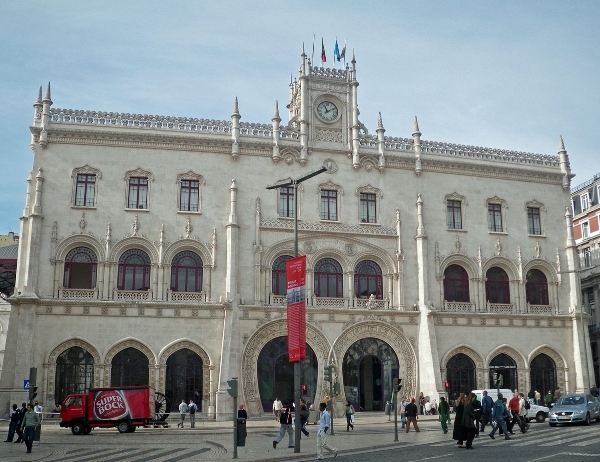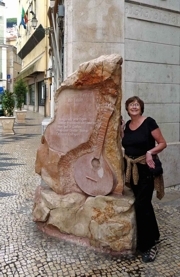By Rick Millikan
While Nieuw Amsterdam shipmates cruise homeward across the mid-Atlantic, we investigate Lisbon, fascinating capital of one of Europe’s earliest empires. Nowadays nicknamed the San Francisco of Europe, Lisbon’s Golden Gate, the magnificent Vasco da Gama Bridge spans the Tagus River. Its electric trams climb steep hillsides. And yes, this city also has earthquakes. Our taxi driver points out a huge statue honoring Marquis de Pompal, who directed reconstruction after its most horrific quake.
 From Pompal’s statue, Avenida Libertad’s black and white mosaic walkway leads us under leafy arcades toward bustling downtown. Though many historic structures were devastated in 1755, what was built afterward intrigues us. We pass art nouveau and 18th century baroque buildings, often embellished by tiles displaying mythic animals, angels and traditional Moorish patterns. Entering sunny Rosio Plaza Ornate, we’re surrounded by more wondrously ornate architecture. The train station’s filigreed and fluted ‘Manulene’ façade presents a 16th century Moorish flair.
From Pompal’s statue, Avenida Libertad’s black and white mosaic walkway leads us under leafy arcades toward bustling downtown. Though many historic structures were devastated in 1755, what was built afterward intrigues us. We pass art nouveau and 18th century baroque buildings, often embellished by tiles displaying mythic animals, angels and traditional Moorish patterns. Entering sunny Rosio Plaza Ornate, we’re surrounded by more wondrously ornate architecture. The train station’s filigreed and fluted ‘Manulene’ façade presents a 16th century Moorish flair.
 In Plaza San Pedro, two fountains flank an impressive column topped with the statue of the plaza’s namesake Pedro IV, King of Portugal and First Emperor of Brazil. On one side, Donna Maria II, a 19th century post-classic theatre replaced an earlier inquisition palace. Pastel edifices embrace the other three sides; paved pedestrian-only marble streets fan north, south and to the west where pink-arcaded ministry buildings border Commerico, a third plaza.
In Plaza San Pedro, two fountains flank an impressive column topped with the statue of the plaza’s namesake Pedro IV, King of Portugal and First Emperor of Brazil. On one side, Donna Maria II, a 19th century post-classic theatre replaced an earlier inquisition palace. Pastel edifices embrace the other three sides; paved pedestrian-only marble streets fan north, south and to the west where pink-arcaded ministry buildings border Commerico, a third plaza.
Nearby stands a renaissance cathedral that triumphantly withstood Lisbon’s horrific quake. The façade bordering its large portal features a series of angels in prayer. Another survivor, 15th century ‘Casa de Bicos’ sprouts hundreds of stony ‘bicos,’ pyramidal protrusions.
Aboard a trolley, we wind upward through Alfama’s narrow streets to Castle of St. George. Inside the primary gate, we circle its lower wall viewing its brass cannons and magnificent city panoramas. Crossing a medieval moat through a second gate, we examine the main fortification and try to imagine how hundreds of soldiers lived in this austere setting. Well-worn steps lead a lofty series of interwoven ramparts and into impressive outer turrets.
Two archeological sites stretch below these walls: a Moorish settlement and first century Roman administrator’s dwelling. And a former royal palace serves as a museum exhibiting artifacts of the cultures that long occupied this fortified hill. Pottery chards and tiles reflect their techniques and artistry. Stamps on their earthenware vessels reflect this area’s historic production of olive oil and wine. Descending through a maze of streets, we pass locals, looking like descendants of those ancient Moors.
At the edge of another sunny plaza, Chris spots a small plaque dedicated to the Fado, Portugal’s traditionally acclaimed music. A sweet melancholic example emanates from a local bar. Though no expert, I recognize the expressive singer, Amalia Rodriques, beloved fado queen. Interestingly, we also find a garden dedicated to her near our hotel. Our day ends inside a corner pasteleria where we savor traditional vegetable soups and delicious breads filled with salami and roast pork.
The next morning a clattering trolley carries us along the Tagus River to Bellem Tower. Constructed during the Age of Discovery, this four-story ornate gateway was defensive and ceremonial. A short stroll away, Monument to Discoveries rises 52-metres above a mosaic world map depicting routes of Portuguese explorers. Aboard its sculpted ship-prow stand statues of prominent royalty, missionaries, cartographers, scientists and explorers; da Gama, Magellan and Cabral flank Henry the Navigator.
Southward, Lisbon’s 1998 World’s Fair site remains largely intact near 17-kilometer Vasco da Gama Bridge. Here the world commemorated 500 years of discovery largely initiated by the Portuguese. So, our delightful investigations conclude with further reflections on Lisbon’s past glory, fascinating culture as well as promising future.
When You Go:
* Holland America ships offer three summer European itineraries and five springtime Caribbean cruises. Check out the possibilities at: www.hollandamerica.com